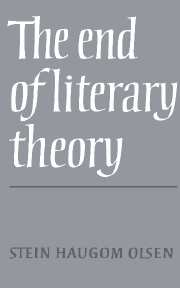Book contents
- Frontmatter
- Contents
- Preface
- Literary aesthetics and literary practice
- Interpretation and intention
- Authorial intention
- Text and meaning
- The ‘meaning’ of a literary work
- Defining a literary work
- What is poetics?
- On unilluminating criticism
- Criticism and appreciation
- Value-judgements in criticism
- Literature, fiction, and reality. A problematic relationship
- Thematic concepts: where philosophy meets literature
- Literary theory and literary aesthetics
- Notes
- Bibliography
- Index
The ‘meaning’ of a literary work
Published online by Cambridge University Press: 05 November 2011
- Frontmatter
- Contents
- Preface
- Literary aesthetics and literary practice
- Interpretation and intention
- Authorial intention
- Text and meaning
- The ‘meaning’ of a literary work
- Defining a literary work
- What is poetics?
- On unilluminating criticism
- Criticism and appreciation
- Value-judgements in criticism
- Literature, fiction, and reality. A problematic relationship
- Thematic concepts: where philosophy meets literature
- Literary theory and literary aesthetics
- Notes
- Bibliography
- Index
Summary
ONE
As mentioned in the previous essay, one of the major developments in literary theory in the last half century has been the rise to theoretical prominence of the concept of meaning. The concept of meaning has emerged as a tool not merely in the literary analysis of words and sentences, but it has also come to be used with reference to literary works themselves. Locutions like ‘the meaning of the poem’, ‘the meaning of the work’, ‘poetic meaning’, and ‘literary meaning’ have appeared in the formulation of central problems in literary theory, and it has become a critical commonplace that the literary work is a verbal expression, a verbal construct or an utterance, and that as such its peculiar nature is defined through the special way in which it means. There are different theories about the way in which a literary work means. The difference between the theories is in their choice of analogy for the literary work and in their choice of a semantic theory on which they can draw for terms and conventions to use in an explanation of literary meaning. There are three main types of theory about literary meaning: autonomy theories, developed on the back of the practice of the New Criticism; semiotic theories, developed under the influence of the rising discipline of theoretical linguistics; and intentionalist theories, inspired by speech-act theory and Gricean analyses of meaning.
- Type
- Chapter
- Information
- The End of Literary Theory , pp. 53 - 72Publisher: Cambridge University PressPrint publication year: 1987
- 1
- Cited by



